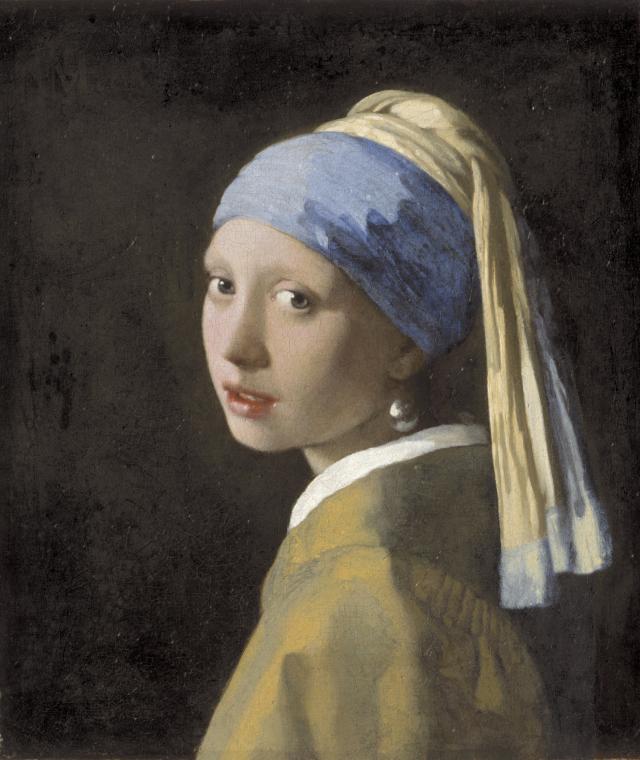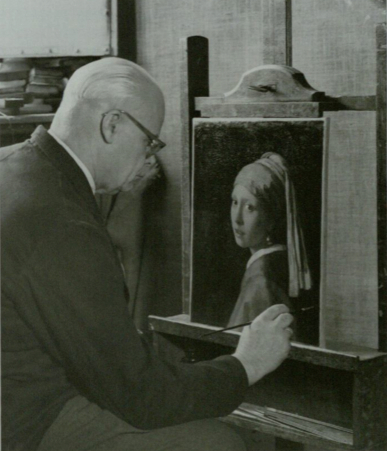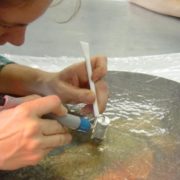Old Dutch Masters in New York: Mottled Vermeers in Manhattan Collections
Ruth Osborne

Johannes Vermeer (1632–1675)
Girl with a Pearl Earring, c. 1665
Oil on canvas 44.5 x 39 cm
Courtesy: Royal Picture Gallery Mauritshuis, The Hague.
Vermeer, Rembrandt, and Hals: Masterpieces of Dutch Paintingfrom the Mauritshuis
(Oct. 22, 2013 – Jan. 19, 2014)
This week, The Frick Collection in New York is set to open their exhibition of Dutch master paintings from the Mauritshuis collection. For the final leg of its American tour these objects will now have traveled over 3,000 miles from the Royal Picture Gallery Mauritshuis in The Hague to line the walls of the late Frick’s home through mid-January.[1]
What most of the (inevitably) millions of visitors will fail to take into account when viewing infamous canvases like The Girl with a Pearl Earring, is the history of the collection and its treatment. One must consider the pollutants and poor climate of the Picture Gallery throughout the nineteenth-century, as well as, most importantly, changing approaches to cleaning that impacted restoration treatments throughout its two-hundred year-old history. Under one director in the 1840s, for instance, there was invasive relining and heavy-handed varnishing that forever worsened several important paintings.[2]
It is particularly crucial to lay out a history of treatment and alteration for the works of an artist like Vermeer, studied for centuries as inimitable in his use of natural light and tone. While conservators purportedly work towards a closer vision of the original Dutch master’s hand, this is precisely what has now, as a result, become forever altered. What happens when this hand appears different in two paintings labeled “Vermeer” hanging side-by-side on museum walls? What happens when one no longer sees visual consistency across his canvases?

Mauritshuis restorer J.C. Traas restoring Girl with a Pearl Earring, 1960.
Vermeers in New York collections also carry varied histories of conservation, as can be expected from an artist whose works have survived nearly four centuries, They each have individual stories, which for us today means they are now nearly as varied as paintings by completely different artists. As art historian Erik Larsen states on the Met’s Woman with a Lute: “We have here a much skinned and damaged painting…Very little in this work seems to indicate Vermeer’s original technique, brush stroke, and savoir faire.”Larsen can only infer “the composition seems to belong to Vermeer…” This is not very reassuring. [3]
What concerns ArtWatch is how these paintings are now being presented to and perceived by the public who views them on the gallery walls, without understanding of their treatment history. We hope this review of Vermeers in New York collections will open up a new and better understanding of how the Dutch master has, in a rather muddied demeanor, entered into our modern consciousness.
[1] “Vermeer, Rembrandt, and Hals: Masterpieces of Dutch Paintings from the Mauritshuis October 22, 2013, through January 19, 2014.” The Frick Collection, New York. Press Image List; “Masterpieces from the Mauritshuis to travel in 2012 to the United States. First Major U.S. Tour in nearly thirty years.” The Hague, January 27, 2011. Press Release. Mauritsuis, The Royal Picture Gallery. http://www.mauritshuis.nl/
[2] Preserving Our Heritage: Conservation, Restoration, and Technical Research at the Mauritshuis. 19-33.
[3] Erik Larsen, “Jan Vermeer,” Master Artists Library Series. Ed. Antonio Paolucci, 1998.










Leave a Reply
Want to join the discussion?Feel free to contribute!